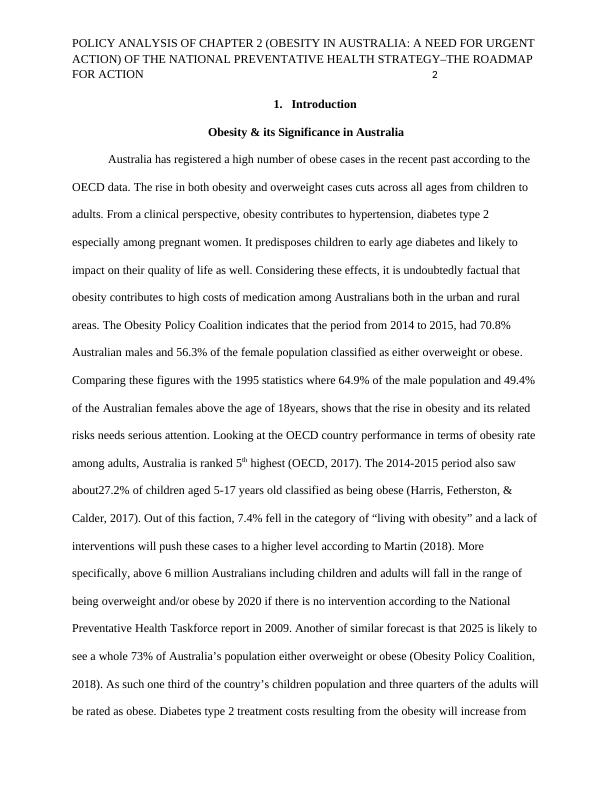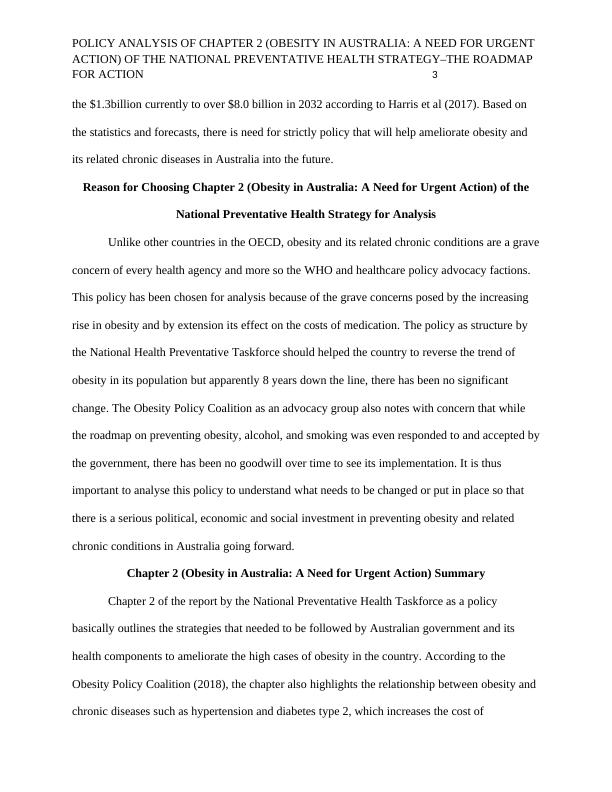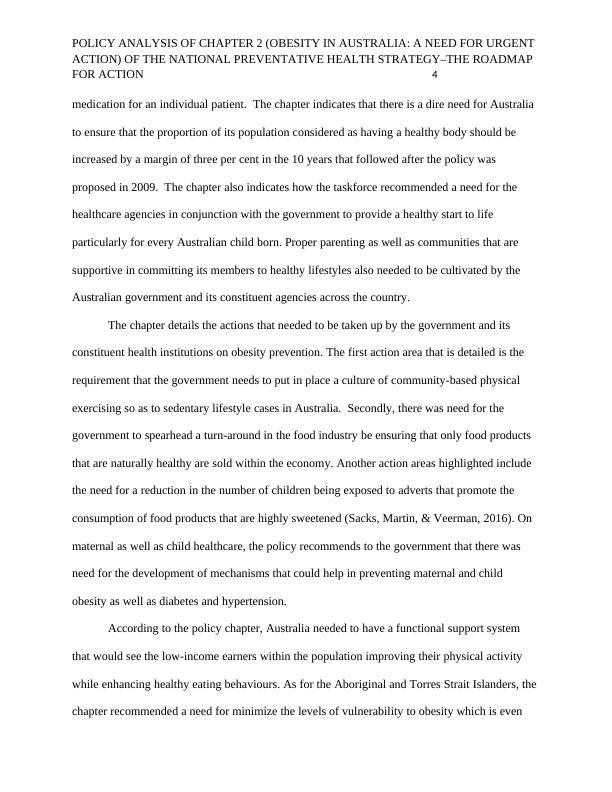Ask a question from expert
Obesity in Australia: A Need for Urgent Action
14 Pages3972 Words176 Views
Added on 2021-05-31
Obesity in Australia: A Need for Urgent Action
Added on 2021-05-31
BookmarkShareRelated Documents
Running Head: POLICY ANALYSIS OF CHAPTER 2 (OBESITY IN AUSTRALIA: A NEED FOR URGENT ACTION) OF THE NATIONAL PREVENTATIVE HEALTH STRATEGY–THE ROADMAP FOR ACTION Policy Analysis of Chapter 2 (Obesity in Australia: A Need for Urgent Action) of the NationalPreventative Health Strategy–The Roadmap for Action Student’s NameInstitutional AffiliationInstructor

POLICY ANALYSIS OF CHAPTER 2 (OBESITY IN AUSTRALIA: A NEED FOR URGENT ACTION) OF THE NATIONAL PREVENTATIVE HEALTH STRATEGY–THE ROADMAP FOR ACTION 21.IntroductionObesity & its Significance in AustraliaAustralia has registered a high number of obese cases in the recent past according to the OECD data. The rise in both obesity and overweight cases cuts across all ages from children to adults. From a clinical perspective, obesity contributes to hypertension, diabetes type 2 especially among pregnant women. It predisposes children to early age diabetes and likely to impact on their quality of life as well. Considering these effects, it is undoubtedly factual that obesity contributes to high costs of medication among Australians both in the urban and rural areas. The Obesity Policy Coalition indicates that the period from 2014 to 2015, had 70.8% Australian males and 56.3% of the female population classified as either overweight or obese. Comparing these figures with the 1995 statistics where 64.9% of the male population and 49.4% of the Australian females above the age of 18years, shows that the rise in obesity and its related risks needs serious attention. Looking at the OECD country performance in terms of obesity rate among adults, Australia is ranked 5th highest (OECD, 2017). The 2014-2015 period also saw about27.2% of children aged 5-17 years old classified as being obese (Harris, Fetherston, & Calder, 2017). Out of this faction, 7.4% fell in the category of “living with obesity” and a lack ofinterventions will push these cases to a higher level according to Martin (2018).More specifically, above 6 million Australians including children and adults will fall in the range of being overweight and/or obese by 2020 if there is no intervention according to the National Preventative Health Taskforce report in 2009. Another of similar forecast is that 2025 is likely tosee a whole 73% of Australia’s population either overweight or obese (Obesity Policy Coalition, 2018). As such one third of the country’s children population and three quarters of the adults willbe rated as obese. Diabetes type 2 treatment costs resulting from the obesity will increase from

POLICY ANALYSIS OF CHAPTER 2 (OBESITY IN AUSTRALIA: A NEED FOR URGENT ACTION) OF THE NATIONAL PREVENTATIVE HEALTH STRATEGY–THE ROADMAP FOR ACTION 3the $1.3billion currently to over $8.0 billion in 2032 according to Harris et al (2017). Based on the statistics and forecasts, there is need for strictly policy that will help ameliorate obesity and its related chronic diseases in Australia into the future.Reason for Choosing Chapter 2 (Obesity in Australia: A Need for Urgent Action) of theNational Preventative Health Strategy for AnalysisUnlike other countries in the OECD, obesity and its related chronic conditions are a graveconcern of every health agency and more so the WHO and healthcare policy advocacy factions. This policy has been chosen for analysis because of the grave concerns posed by the increasing rise in obesity and by extension its effect on the costs of medication. The policy as structure by the National Health Preventative Taskforce should helped the country to reverse the trend of obesity in its population but apparently 8 years down the line, there has been no significant change. The Obesity Policy Coalition as an advocacy group also notes with concern that while the roadmap on preventing obesity, alcohol, and smoking was even responded to and accepted bythe government, there has been no goodwill over time to see its implementation. It is thus important to analyse this policy to understand what needs to be changed or put in place so that there is a serious political, economic and social investment in preventing obesity and related chronic conditions in Australia going forward.Chapter 2 (Obesity in Australia: A Need for Urgent Action) SummaryChapter 2 of the report by the National Preventative Health Taskforce as a policy basically outlines the strategies that needed to be followed by Australian government and its health components to ameliorate the high cases of obesity in the country. According to the Obesity Policy Coalition (2018), the chapter also highlights the relationship between obesity and chronic diseases such as hypertension and diabetes type 2, which increases the cost of

POLICY ANALYSIS OF CHAPTER 2 (OBESITY IN AUSTRALIA: A NEED FOR URGENT ACTION) OF THE NATIONAL PREVENTATIVE HEALTH STRATEGY–THE ROADMAP FOR ACTION 4medication for an individual patient. The chapter indicates that there is a dire need for Australia to ensure that the proportion of its population considered as having a healthy body should be increased by a margin of three per cent in the 10 years that followed after the policy was proposed in 2009. The chapter also indicates how the taskforce recommended a need for the healthcare agencies in conjunction with the government to provide a healthy start to life particularly for every Australian child born. Proper parenting as well as communities that are supportive in committing its members to healthy lifestyles also needed to be cultivated by the Australian government and its constituent agencies across the country. The chapter details the actions that needed to be taken up by the government and its constituent health institutions on obesity prevention. The first action area that is detailed is the requirement that the government needs to put in place a culture of community-based physical exercising so as to sedentary lifestyle cases in Australia. Secondly, there was need for the government to spearhead a turn-around in the food industry be ensuring that only food products that are naturally healthy are sold within the economy. Another action areas highlighted include the need for a reduction in the number of children being exposed to adverts that promote the consumption of food products that are highly sweetened (Sacks, Martin, & Veerman, 2016). On maternal as well as child healthcare, the policy recommends to the government that there was need for the development of mechanisms that could help in preventing maternal and child obesity as well as diabetes and hypertension. According to the policy chapter, Australia needed to have a functional support system that would see the low-income earners within the population improving their physical activity while enhancing healthy eating behaviours. As for the Aboriginal and Torres Strait Islanders, the chapter recommended a need for minimize the levels of vulnerability to obesity which is even

End of preview
Want to access all the pages? Upload your documents or become a member.
Related Documents
Policy Analysis: The National Preventative Health Strategy – The Roadmap for Action 30 June 2009 (Obesity Prevention)lg...
|15
|4353
|248
The Australian’s Health Policy PDFlg...
|4
|889
|69
Probable Consequences of Incorporating Sugar Tax in Australialg...
|12
|2920
|78
Childhood Obesity: Causes, Consequences and Prevention Strategieslg...
|6
|1570
|206
Health Promotion: A Critical Analysis of the National Preventative Health Taskforce Reportlg...
|10
|2910
|96
Physical inactivity as a risk factor of chronic disease burden in Australialg...
|9
|2224
|136